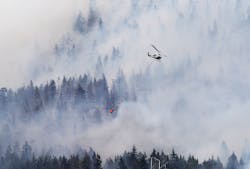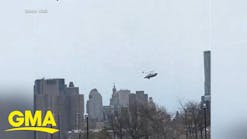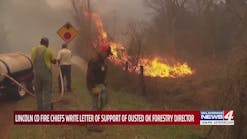Fire Officials Say Luck Could Run Out for Wash. Forest
Source Yakima Herald-Republic, Wash.
Some call it the "asbestos forest" because it's never suffered a devastating fire like the one raging east of Cle Elum.
But that's the puzzle because the sagebrush, grass and trees on the eastern flanks of the Cascades west of Yakima are no different than the places now burning.
Fire officials say it's just dumb luck that areas, such as those around Rimrock Lake, haven't been seen a huge, destructive blaze. And, they are quick to add, that luck could run out at any moment.
"I would like to say, it's because we're on top of the fires when they do start here, that our crews get right on 'em, but that's also the case for everybody else," said Doug Jenkins, a spokesman with the Naches Ranger District. "The same thing can happen here as is going on in Cle Elum."
The fire that has consumed more than 28,000 acres and destroyed at least 60 homes east of Cle Elum is suspected of being started Monday afternoon by a spark from a construction crew working on the Taylor Bridge on State Route 10 along the Yakima River.
That area has much of the same scrubland-sagebrush terrain as the Naches District in western Yakima County. It's had the same dry weather, nearly the same high temperatures, and imposed the same campfire ban this summer as Kittitas County.
So why upper Kittitas County and not western Yakima County?
"That's a question that has been asked for a long time," Jenkins said. "Why are we not seeing these large fires in our district like they've seen up north?"
He said fire crews like to think that it could never happen, and that they're prepared for any contingency, but there's a "high probability" that a large-scale fire will happen someday.
"We're extremely vulnerable to that same type of fire activity, especially as these temperatures remain in the 90s and are expected to be in the triple digits," he said. "A spark from a chainsaw could do the same thing, and if conditions are right, it's going to go ballistic."
On the east side of the Cascades, large fires are not uncommon, particularly in the hot, dry summers.
Last year was the 10-year anniversary of Thirtymile Fire in the Okanogan National Forest, which killed four young firefighters from Yakima and Ellensburg. Last summer saw a 3,600-acre fire north of Goldendale, which destroyed dozens of structures. Further north, the area between Wenatchee and Chelan sees significant fires almost every year.
But while Yakima County experiences regular brush fires, it hasn't seen anything on the scale of the Taylor Bridge fire.
"Pure luck," said Chief Steve Smith of the Nile Fire District, which includes its share of scrub pine, sagebrush and grasslands. "We have the same fire conditions, weather, humidity and everything that they do; we've just been lucky."
Within the Naches District, there are approximately 570 summer homes and other structures.
There are also large camps, such as Camp Dudley and Camp Roganunda, and
small communities,
including East Prairie, Cliffdell and Rimrock Retreat.
Part of the risk, Jenkins said, is that a lot of those places offer "one way in and one way out," without an alternate escape route.
"I think we've been extremely lucky that we haven't seen this," he said. "It's not a matter of if, it's a matter of when.'"
Smith agreed.
"It doesn't take much to set it off. Just a careless cigarette or a match or a firecracker; you name it," he said.
"They've even had cases where a (glass) pop bottle -- the sun will go through it just the right way and start a fire, like a magnifying glass."
The Nile Fire District sends out newsletters and puts warnings on billboards to remind people of fire safety measures. The campfire burn ban extends to anything that emits a spark or generates ash, including briquettes.
Woodcutting is also banned currently because of the risk of sparks from chainsaws.
"I just don't think people should have any kind of flame when they're up there, because they're so vulnerable," Jenkins said.
Jenkins says the Naches District works on burning excess fuels and other measures to make the forest more resilient if a fire were to happen.
Maintaining a well-irrigated green belt around homes is important within the Yakima city limits, too, says Yakima deputy fire marshal Brandon Dorenbush.
Up on Scenic Drive, for instance, "Just because they have those junipers and arborvitae -- they look green, but deep down inside they're dry," he said.
"If you have a wildfire that starts at the bottom and works its way up the hill, just because it looks green doesn't mean it's going to be a buffer for you."
This year's long, wet spring allowed grasses and ground cover to grow tall, which has since turned into a plentiful supply of dry fuel.
Jenkins encourages people to call 911 if they ever see smoke in the forest. Firefighters are also on lookout duty to ensure a fast response time.
Still, within that response time, a lot can happen.
"Is it possible for something to occur here? Absolutely," Dorenbush said. "Are we prepared for it? That's a pretty subjective question ... The best thing we can tell people is just to be very cautious."
Copyright 2012 - Yakima Herald-Republic, Wash.
McClatchy-Tribune News Service






